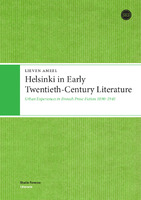Helsinki in Early Twentieth-Century Literature: Urban Experiences in Finnish Prose Fiction 1890-1940
Abstract
"Helsinki in Early Twentieth-Century Literature analyses experiences of the Finnish capital in prose fiction published in Finnish in the period 1890–
1940. It examines the relationships that are formed between Helsinki and
fictional characters, focusing, especially, on the way in which urban public
space is experienced. Particular attention is given to the description of
movement through urban space. The primary material consists of a selection of more than sixty novels, collections of short stories and individual
short stories. This study draws on two sets of theoretical frameworks: on
the one hand, the expanding field of literary studies of the city, and on the
other hand, concepts provided by humanistic and critical geography, as well
as by urban studies.
This study is the first monograph to examine Helsinki in literature written
in Finnish. It shows that rich descriptions of urban life have formed an
integral part of Finnish literature from the late nineteenth century onward.
Around the turn of the twentieth century, literary Helsinki was approached
from a variety of generic and thematic perspectives which were in close
dialogue with international contemporary traditions and age-old images
of the city, and defined by events typical of Helsinki’s own history. Helsinki
literature of the 1920s and 1930s further developed the defining traits that
took form around the turn of the century, adding a number of new thematic
and stylistic nuances. The city experience was increasingly aestheticized and internalized. As the centre of the city became less prominent in literature, the margins of the city and specific socially defined neighbourhoods gained in importance.
Many of the central characteristics of how Helsinki is experienced in the
literature published during this period remain part of the ongoing discourse
on literary Helsinki: Helsinki as a city of leisure and light, inviting dreamy
wanderings; the experience of a city divided along the fault lines of gender,
class and language; the city as a disorientating and paralyzing cesspit of vice; the city as an imago mundi, symbolic of the body politic; the city of everyday and often very mundane experiences, and the city that invites a profound sense of attachment – an environment onto which characters project their innermost sentiments."
Keywords
urban public space; flâneur; helsinki; literary city; modernism; Finland; Protagonist; Working classDOI
10.21435/sflit.8ISBN
9789522227430;9789522225672OCN
1030817507Publisher
Finnish Literature Society / SKSPublication date and place
Helsinki, 2014Series
Studia Fennica Litteraria, 8Classification
Man-made objects depicted in art
Literature: history and criticism
Literary studies: c 1900 to c 2000
Literary studies: fiction, novelists and prose writers


 Download
Download Web Shop
Web Shop